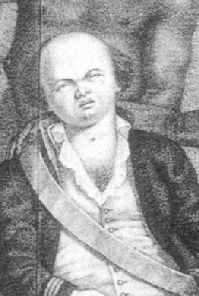PINEDA Y RAMÍREZ, Antonio (Guatemala, 1751 - Luzón, 1792)

The dying Antonio Pineda
Engraving by José Vázquez, from a sketch by Giovanni
Ravenet
(Museo Naval,
Madrid)
Antonio Pineda y Ramírez (Guatemala, 1751 - Luzón, 1792), was an army officer and naturalist. His scientific training took place under the guidance of Casimiro Gómez Ortega, director of the Jardín Botánico in Madrid. He was given the job of coordinating all the naturalist work of the Malaspina Expedition. During the Expedition's stay at Montevideo, Pineda got to know the naturalist Félix de Azara, who gave him many manuscripts, which proved very valuable, on the zoology of Paraguay and the River Plate. On the island of Luzón, having trekked into an extremely unhealthy region in the interior, he became mortally ill. His manuscripts were entrusted to his brother Arcadio - also an officer of the Expedition - who, however, lacked the knowledge necessary for compiling them properly, so that it was many years before they were published, and then only partially. Malaspina, in the last pages of the diary of his voyage, wrote an admiring eulogy to the memory of Pineda.
For more information, see:
M.D. HIGUERAS RODRÍGUEZ, "Don Antonio Pineda y la ExpediciónMarch 8, 202094. Viaje a América y Oceanía de las corbetas Descubierta y Atrevida, Madrid, Ministerio de Cultura - Ministerio de Defensa, 1984, pp. CXXII-CXXX.
A. GALERA GÓMEZ, La Ilustración española y el conocimiento del Nuevo Mundo. Las Ciencias Naturales en la Expedición Malaspina: la labor científica de Antonio Pineda, Madrid, Consejo Superior de Investigaciones Científicas, 1988, 277 pp.
A. GALERA GÓMEZ, "La Botánica en el proyecto científico de Antonio Pineda," La Botánica en la Expedición Malaspina, Madrid, Lunwerg, 1989, pp. 38-46.
A. GALERA GÓMEZ, "Antonio Pineda y el proyecto científico de la expedición Malaspina," La ciencia española en ultramar. Actas de las I Jornadas sobre "España y las expediciones científicas en América y Filipinas", Aranjuez, Doce Calles, 1991, pp. 257-264.
Image courtesy of the Centro di Studi Malaspiniani, Mulazzo, Italy. Biographical and bibliographical note by Dario Manfredi (Italian version), translated by John Black.
Updated: March 8, 2020